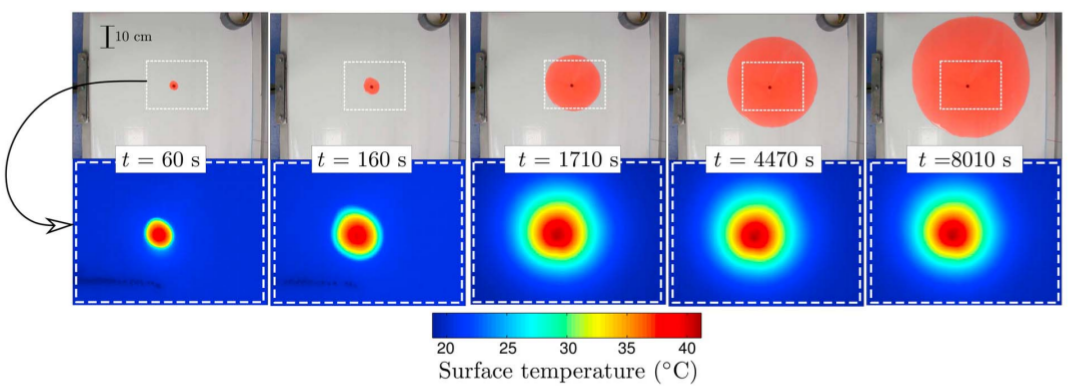BENCHMARKING LAVA FLOWS - BM3- HORIZONTAL COOLING VISCOUS SPREADING FROM A POINT SOURCE
Category
Published on
Abstract
The lava flow team has agreed on benchmarking series.
Among which, benchmark #3 is the first to deal with a non-isothermal flow.
It is a first step between the "spreading" benchmarks BM#1 and BM#2 and the "complex" lava benchmark BM#4 and BM#5.
The benchmark BM#3 test deals with the spreading and the cooling of an isoviscous flow, injected at a hot temperature from a point source at a constant supply rate, and cooling into the air while spreading onto a horizontal support.
Flow Characteristics:
The material is silicone oil, a newtonian liquid injected at a constant supply rate. The flow spreads onto a horizontal flat support. As it spreads, it cools down from the source temperature to the ambient air temperature by radiation and convection.
This benchmark is based on the analogue experiments presented in Garel et al. (2012).
The viscosity of silicone oil does not depend much on temperature (see data file)
Hence temperature is only considered as a passive tracer in this benchmark, with no feedback between thermal structure and rheology.
The figure below shows the flow advance and the evolution of surface temperatures with time. A thermal steady state is reached after a transient time.

Flow input parameters
The test corresponds to the experiment C14 of Garel et al. (2012). This experiment has a duration of 2.3 hours.
- Vent geometry: point source,
- Slope: horizontal support,
- Supply rate 2.2 10-8 m3/s,
- Viscosity: 3.4 Pa.s,
- Density: 954 kg/m3,
- Source temperature: 42oC,
- Ambient air temperature: 20oC,
- Specific heat: 1500 J/kg/K,
- Thermal conductivity: 0.15 W/m/K,
- Emissivity 0.96,
- Convective heat transfer coefficient: 2 W/m2/K.
Model outputs
We measure (i) the flow front advance with time (that corresponds to the solution of Huppert, 1982), and (ii) the evolution of the surface temperatures with radial distance from the source and time. See the readme file for more explanation.
Model should be able to reproduce the establishment of a steady state for surface temperatures, even though the viscous flow continues to spread as the square root of time. The figure below presents the evolution of the radial temperature profile as a function of time (dimensionless temperature is (T-Ta)/(T0-Ta), with T0 and Ta the source and ambient temperatures, respectively).

References:
Garel, F., E. Kaminski, S. Tait, and A. Limare (2012), An experimental study of the surface thermal signature of hot subaerial isoviscous gravity currents: Implications for thermal monitoring of lava flows and domes, Journal of Geophysical Research, 117 (B2), doi:10.1029/2011JB008698.
Huppert, H.E. (1982), Propagation of two-dimensional and axisymmetric viscous gravity currents over a rigid horizontal surface, Journal of Fluid Mechanics, 121(1), 43–58.